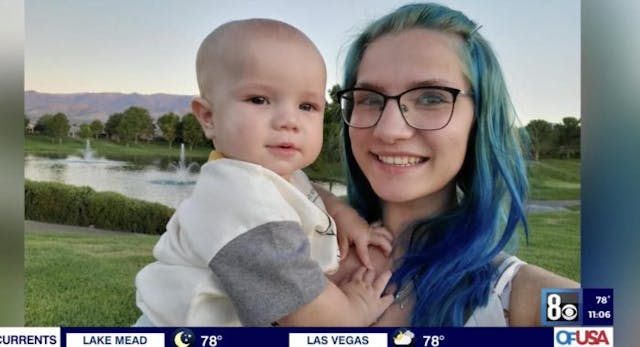Amber Thurman should still be here. This is the dangerous reality of abortion bans. They block people from getting timely, routine, and lifesaving care. propublica.org/article/georgi…

FEIGNED FURY: Abortion advocates only care about abortion pill clients dying in pro-life states
Abortion Pill·By Nancy Flanders
FEIGNED FURY: Abortion advocates only care about abortion pill clients dying in pro-life states
Vice President and presidential hopeful Kamala Harris is expressing fury over the tragic death of a young mother from Georgia, Amber Thurman, who died from sepsis following her use of the abortion pill in 2022 just two months after Roe v. Wade was overturned. But her anger is misdirected at the state’s pro-life law, which is not to blame for Thurman’s death, despite the abortion industry quickly pointing the finger without any proof.
Multiple women have died from infection and sepsis following the use of the abortion pill. Where was the outrage when those women died in pro-abortion states and while Roe v. Wade was still in place? There’s a simple explanation: the outrage is selective, and the fury is feigned. Abortion advocates look for (and in some cases, actually create) opportunities to blame abortion restrictions for harming women, yet consistently turn a blind eye when it is clear that abortion itself has harmed women.
After news of Thurman’s death was publicized by ProPublica (about a year after gathering the details from Thurman’s family), other media immediately began to circulate the story with misleading headlines, claiming that she had died because of a state’s pro-life laws. That false narrative is now being shared by Harris and others, who are using Thurman’s death to promote legalized abortion.
“This is exactly what we feared when Roe was struck down. These are the consequences of Donald Trump’s actions,” said Harris.
This is false.
Thurman’s death comes after years of lies from the pro-abortion media, the abortion industry, and pro-abortion government officials about the dangers of the abortion pill.
Women have been dying after taking the abortion pill since the days when Roe v. Wade was in place, but abortion advocates never seemed to care. In fact, they sometimes buried the truth to protect the abortion pill.
A history of death connected to the abortion pill
Five initial deaths of unknown women
After the abortion pill mifepristone was approved for use in the U.S. in 2000, five women died. The first died in Canada in 2001 after her uterus became infected with Clostridium sordellii, a bacteria naturally found in the GI tract that can cause infection, sepsis, and fatal toxic shock. The four other women died in the same way from Clostridium sordellii infections after taking misoprostol (the second drug in the abortion pill regimen) vaginally.
The Canadian woman’s death was made public on September 10, 2001, leading Beverly Winikoff, founder of Gynuity Health Projects — the sponsor of controversial abortion pill clinical trials on girls as young as 10 — to credit the September 11, 2001, terrorist attack on America with ‘saving’ the abortion pill. The woman’s death never made major headlines.
After those deaths, it was determined that misoprostol should also be taken orally in an effort to avoid Clostridium sordellii infections. Yet, deaths from infection are still occurring due to incomplete abortions (with retained body parts and pregnancy tissue) associated with the abortion pill. This is despite the fact that mifepristone’s packaging contains a black box warning about the risk of sepsis on the box.
Holly Patterson (California, 2003)

Holly Patterson was 18 and living in California when she died on September 17, 2003, from septic shock caused by a Clostridium sordellii infection after taking the abortion pill. She had been given a non-FDA-approved regimen of the abortion pill at Planned Parenthood and may have administered misoprostol vaginally.
Her father Monty Patterson explained that, 12 days after her 18th birthday, Patterson went to Planned Parenthood and was given the abortion pill.
“By the fourth day she was admitted to the emergency room of a local hospital,” he said. “She was examined. She was given painkillers. She complained of bleeding, cramping, constipation and pain. But subsequently she was sent home.”
Despite living in a pro-abortion state under Roe v. Wade, Patterson did not receive the care she needed for her abortion complications.
Seven days after taking the abortion pill, she returned to the hospital complaining of weakness, vomiting, and abdominal pain and she later died from “a massive bacterial infection as a result of a drug-induced abortion…” said her father.
Alyona Dixon (Nevada, 2022)

Alyona Dixon, a 24-year-old Las Vegas mother, died from “septic abortion” in 2022 just days after obtaining the abortion pill at a Planned Parenthood, according to a wrongful death lawsuit filed in the pro-abortion state of Nevada. The complaint did not name Planned Parenthood; it named Dignity Health’s Blue Diamond campus, arguing that the medical facility “should have seen the severity of Dixon’s problems … and properly treated her.”
The lawsuit alleged that Dignity Health (et al.) “failed to exercise that degree of care, diligence, and skill ordinarily exercised by nurses, medical providers, medical facilities, doctors, and staff in good standing in the community by, among other things, failing to follow the appropriate standard of care in assessing, evaluating, treating and discharging ALYONA.”
The case also alleged that Dignity Health “knew or should have known that a female patient with a history of vaginal bleeding and/or abdominal pain required a pelvic exam and/or a stat consult with an OB/GYN to rule out more serious medical conditions.”
Dixon was about eight weeks pregnant when she took the abortion pill, and abortion is legal for any reason in Nevada up to 24 weeks. Yet, when she needed life-saving medical treatment following her legal, easily accessible abortion, she did not receive it.
Sarah Dunn (United Kingdom, 2020)
Sarah Dunn died from sepsis after taking the abortion pill in March 2020 in the UK at 31 years old. “Group A streptococcus sepsis following termination of pregnancy” was found to be the cause of death. Dr. Alison Armor told the Daily Mail that this is a known complication of the abortion pill.
Yet, despite the legality of abortion in the UK, Louise Rae, Assistant Coroner for Blackpool & Fylde, said Dunn’s symptoms were missed on three separate occasions by a general practitioner, a pharmacist, and hospital staff. Dunn was not given antibiotics for hours after she was admitted to the hospital. If she had been, Rae said she may have survived.
An investigation by the Healthcare Safety Investigation Branch revealed that Dunn’s abortion was not “adequately supervised.”
“I am concerned that there remains a lack of awareness of sepsis in particular following Early Medical Abortion given how many opportunities there were to think sepsis in this case,” said Rae. “Whilst those giving evidence to me in court are now aware of sepsis and the risks post abortion having reflected on Sarah’s death, I am concerned that there is a lack of awareness of the risk of sepsis following Early Medical Abortions. This lack of awareness in my view risks avoidable future deaths.”
Amber Thurman (Georgia, 2022)
Amber Thurman is one of the latest publicized deaths to occur from infection and sepsis after the administration of the abortion pill. ProPublica claimed that Georgia’s pro-life law prohibits the use of the D&C procedure, but this is untrue. A D&C is completely legal in Georgia unless it is being used to intentionally kill the baby in the womb. While preborn babies are protected from induced abortion in the state, a D&C is legal in situations like Thurman’s — and if doctors had acted quickly, she might have survived.
Candi Miller (Georgia, 2022)
Candi Miller learned she was pregnant and was afraid her pregnancy would be dangerous due to her pre-existing health conditions. She ordered abortion pills online from Aid Access, but the abortion pills failed to produce a complete abortion, with parts of Miller’s preborn child left inside of her. It appears that she may have become septic.
According to ProPublica, Miller was scared to see a doctor out of fear of being sent to jail (though the state’s pro-life law doesn’t allow women to be prosecuted for abortion), so she suffered at home until her husband found her unresponsive. An autopsy revealed fetal tissue still in her uterus, confirming that the abortion had been incomplete. It also found a lethal combination of painkillers, including the dangerous opioid fentanyl, though she had no history of drug use. ProPublica claimed a D&C, which Miller would have needed to remove the remaining body parts and pregnancy tissue, is now a felony in Georgia with exceptions, but this is untrue. It is only illegal when used to deliberately kill a preborn baby.
Two unnamed abortion pill patients (Indiana, 2022)
A lawsuit revealed that these women are not alone.
In 2023, it was reported that two maternal deaths were reported in connection with the administration of the abortion pill by Dr. Amy Caldwell in Indiana. One woman was 31 years old at the time, and 21 weeks pregnant with a child who had a “chromosomal abnormality.” According to the Terminated Pregnancy Report dated June 25, 2022, this woman was administered mifepristone and misoprostol — the abortion pill protocol — as part of the abortion process, 11 weeks past the FDA-approved abortion pill limit. Both this woman and her baby died as a result of the abortion.
Another Caldwell patient, age 29, died after taking the abortion pill at seven weeks pregnant — well within the FDA-approved limit. The official causes of death for these two Indiana abortion pill patients were not revealed.
Unknown victims
The number of women harmed by the use of the abortion pill may never be fully understood or known.
In 2022, the American Association of Pro-Life Obstetricians and Gynecologists (AAPLOG) reported that a study found a “significant” gap in the federal government’s reporting of complications associated with the abortion pill. A 2021 study found that abortion pill complications are underreported. As of 2018, 28 U.S. states did not require post-abortion complications to be reported at all.
The abortion pill is not ‘safer than Tylenol and Viagra‘ as the abortion industry claims. It’s actually been shown to be four times more dangerous for women than a first-trimester surgical abortion and there is a black box warning that it can lead to sepsis.
Women deserve the truth. They and their babies deserve to live.
Editor’s Note 9/23/24: This article was updated with new information.
Live Action News is pro-life news and commentary from a pro-life perspective.
Contact editor@liveaction.org for questions, corrections, or if you are seeking permission to reprint any Live Action News content.
Guest Articles: To submit a guest article to Live Action News, email editor@liveaction.org with an attached Word document of 800-1000 words. Please also attach any photos relevant to your submission if applicable. If your submission is accepted for publication, you will be notified within three weeks. Guest articles are not compensated (see our Open License Agreement). Thank you for your interest in Live Action News!
Read Next

Northern Ireland man charged with murder of woman and her preborn child
Bridget Sielicki
·More In Abortion Pill

Abortion Pill
Indian woman dies after taking abortion pill given by cousin
Angeline Tan
·
Abortion Pill
Kentucky woman arrested, charged with fetal homicide
Nancy Flanders
·
Analysis
Judge denies anonymity for victim of forced abortion
Cassy Cooke
·
Politics
South Dakota sues Mayday Health over gas station abortion ads
Bridget Sielicki
·
Human Interest
A pro-life sign saved this little girl's life from abortion
Andrea Trudden
·More From Nancy Flanders

Pop Culture
Political commentator's heartbreaking loss exposes pain of IVF
Nancy Flanders
·
Politics
New Archbishop of Canterbury warns of danger in legalizing assisted suicide
Nancy Flanders
·
Politics
Judge approves class-action settlement requiring Aetna to cover IVF for same sex couples
Nancy Flanders
·
Abortion Pill
Kentucky woman arrested, charged with fetal homicide
Nancy Flanders
·
Politics
Report: Kansas abortions hit record high with 47% increase in minors
Nancy Flanders
·